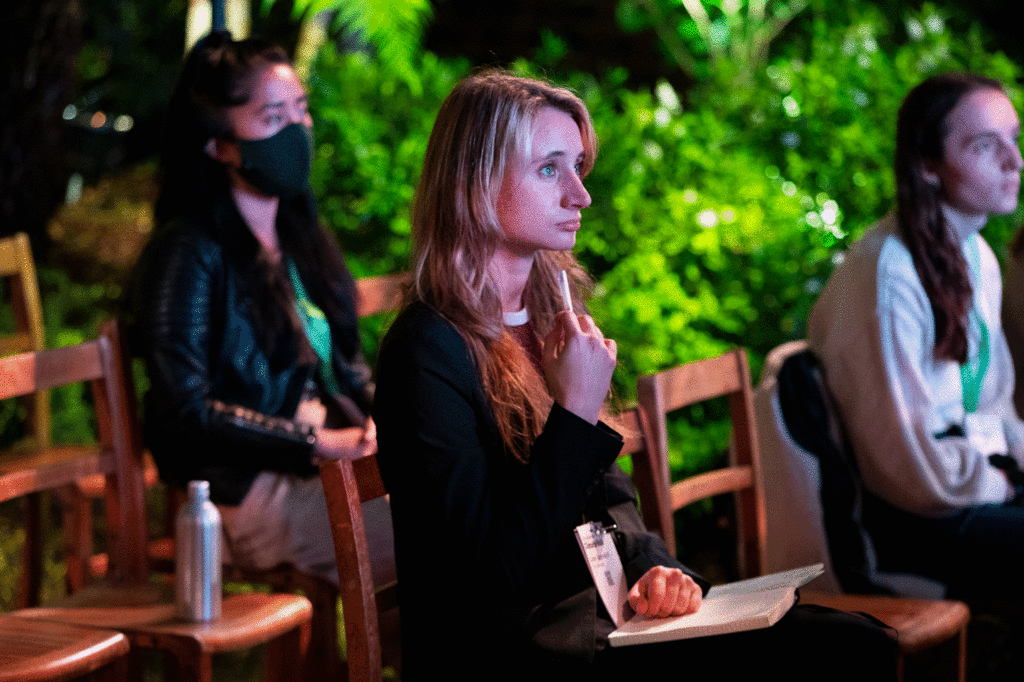Taking action on fashion
 Our age group, 16-24 years old, is the most affected by climate change and yet the least likely to act on it. Ending the day at The New York Times Climate Hub with a clothing swap and fashion show featuring repurposed, reused, and revamped clothing, today’s talks focused on one topic that our age group can be easily reached on: fast fashion. Especially in the United States, we see a never-ending stream of ad campaigns for the next sneaker, next limited-item drops, the next line for the upcoming season. Clothing is something our generation can easily relate to and one we need to change our attitudes towards and take action on.
Our age group, 16-24 years old, is the most affected by climate change and yet the least likely to act on it. Ending the day at The New York Times Climate Hub with a clothing swap and fashion show featuring repurposed, reused, and revamped clothing, today’s talks focused on one topic that our age group can be easily reached on: fast fashion. Especially in the United States, we see a never-ending stream of ad campaigns for the next sneaker, next limited-item drops, the next line for the upcoming season. Clothing is something our generation can easily relate to and one we need to change our attitudes towards and take action on.
The fashion industry is a sector that is often overlooked when it comes to market incentives and government policies directed at companies to reduce pollution and emissions. However, this industry accounts for around 12% of emissions and is the second-largest industrial polluter in the world.
One talk, led by Vanessa Friedman, the fashion director and chief fashion critic for The New York Times, focused on “How to Keep a Product Alive.” She began by sharing that “the term ‘sustainable fashion’ is garbage.” Similar to food, the use of the word “sustainable” has lost meaning and exists mostly as a marketing term. As a result, we have lost marketplace trust. Friedman called for the introduction of standards to the industry, like the way food needs to pass certain reviewable processes to gain the label “non-GMO” or “organic.” A system of verification does not exist for clothing; therefore, the “green” label on clothing has no trustable meaning.
As a student involved in the environmental activism efforts on campus, I recognize my leaning to sustainable practices–along with my friends who are also involved in this work–towards purchasing “eco-friendly,” “sustainable” clothing. Before today it never really occurred to me that there is no way to know if the companies that preach this are honest, and that there are no established industry standard definitions or requirements for these terms.
There are efforts on campus to help reduce fashion waste, such as a clothing swap held by the Office of Sustainability, which is a fantastic first step. But further outreach can educate college students, who have a lot of power in this sector. Changing our fashion consumption habits will make a big difference in doing our part to mitigate climate change.
Another presentation later in the day proposed an interesting method to engage 16–24-year-olds and empower our generation in fighting fast fashion. Crossing Borders: A Campaign to Engage the Next Generation was the winning campaign from a challenge issued to Scots by Fuel Change to engage and encourage their generation to take action against climate change. Their proposal was to halt fast fashion in its tracks by beginning an “off season.” This would take place in January and February, when we would pledge to not purchase clothing. Major clothing companies would direct their ads away from convincing consumers to spend hundreds on a new shoe to not buying anything at all, and even potentially take down their online shopping sites during these two months. This is such a unique and intriguing idea, but as the United States has a very consumerist culture, I wonder if I and other Americans would resist shopping even if major brands aided these marketing campaigns and shopping blackout periods.
The climate issue behind the fashion industry is only now starting to take form and was recognized with a handful of exhibitions at COP26. I hope this movement will grow and that in the future students on campus will run campaigns and foster initiatives to encourage their peers to save money and shop secondhand to benefit the planet.